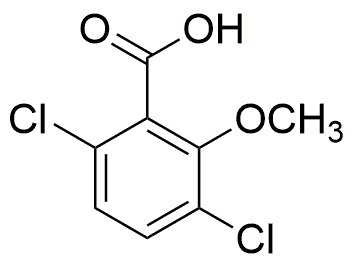Dicamba is widely utilized in research focused on:
- Agricultural Herbicide: Primarily used to control broadleaf weeds in various crops, dicamba is effective in maintaining crop yield and quality, especially in soybean and corn production.
- Environmental Research: Its behavior in soil and water is studied to understand its environmental impact, helping researchers develop better management practices for herbicide application.
- Plant Biology Studies: Researchers use dicamba to investigate plant growth responses and resistance mechanisms, providing insights into plant physiology and genetics.
- Integrated Pest Management (IPM): Dicamba is part of IPM strategies, allowing for more sustainable agricultural practices by reducing reliance on multiple herbicides and promoting crop rotation.
- Development of New Formulations: The chemical serves as a model for developing new herbicide formulations that enhance efficacy and reduce environmental risks, benefiting the agrochemical industry.
General Information
Properties
Safety and Regulations
Applications
Dicamba is widely utilized in research focused on:
- Agricultural Herbicide: Primarily used to control broadleaf weeds in various crops, dicamba is effective in maintaining crop yield and quality, especially in soybean and corn production.
- Environmental Research: Its behavior in soil and water is studied to understand its environmental impact, helping researchers develop better management practices for herbicide application.
- Plant Biology Studies: Researchers use dicamba to investigate plant growth responses and resistance mechanisms, providing insights into plant physiology and genetics.
- Integrated Pest Management (IPM): Dicamba is part of IPM strategies, allowing for more sustainable agricultural practices by reducing reliance on multiple herbicides and promoting crop rotation.
- Development of New Formulations: The chemical serves as a model for developing new herbicide formulations that enhance efficacy and reduce environmental risks, benefiting the agrochemical industry.
Documents
Safety Data Sheets (SDS)
The SDS provides comprehensive safety information on handling, storage, and disposal of the product.
Product Specification (PS)
The PS provides a comprehensive breakdown of the product’s properties, including chemical composition, physical state, purity, and storage requirements. It also details acceptable quality ranges and the product's intended applications.
Certificates of Analysis (COA)
Search for Certificates of Analysis (COA) by entering the products Lot Number. Lot and Batch Numbers can be found on a product’s label following the words ‘Lot’ or ‘Batch’.
*Catalog Number
*Lot Number
Certificates Of Origin (COO)
This COO confirms the country where the product was manufactured, and also details the materials and components used in it and whether it is derived from natural, synthetic, or other specific sources. This certificate may be required for customs, trade, and regulatory compliance.
*Catalog Number
*Lot Number
Safety Data Sheets (SDS)
The SDS provides comprehensive safety information on handling, storage, and disposal of the product.
DownloadProduct Specification (PS)
The PS provides a comprehensive breakdown of the product’s properties, including chemical composition, physical state, purity, and storage requirements. It also details acceptable quality ranges and the product's intended applications.
DownloadCertificates of Analysis (COA)
Search for Certificates of Analysis (COA) by entering the products Lot Number. Lot and Batch Numbers can be found on a product’s label following the words ‘Lot’ or ‘Batch’.
*Catalog Number
*Lot Number
Certificates Of Origin (COO)
This COO confirms the country where the product was manufactured, and also details the materials and components used in it and whether it is derived from natural, synthetic, or other specific sources. This certificate may be required for customs, trade, and regulatory compliance.


